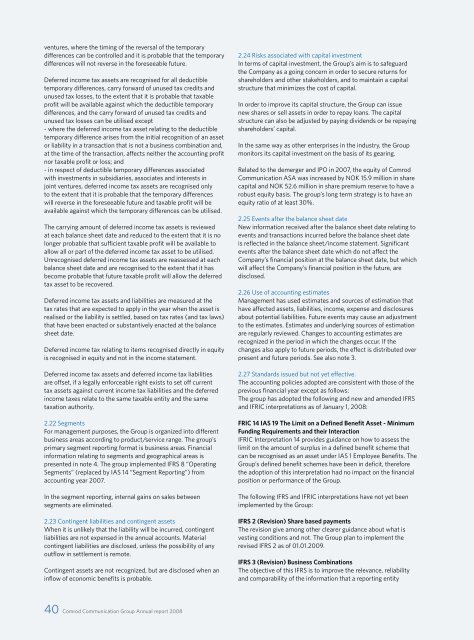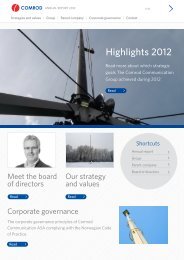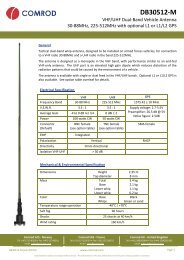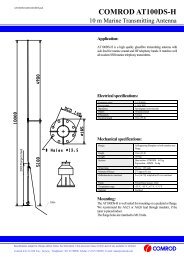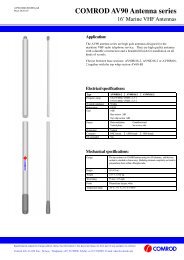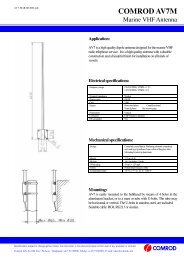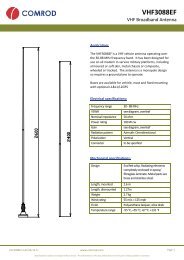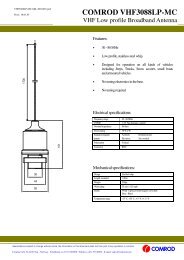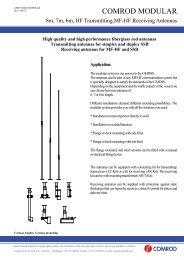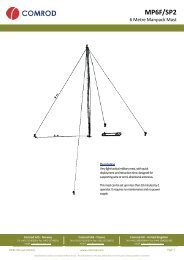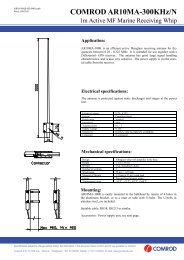Annual report 2008 - Comrod
Annual report 2008 - Comrod
Annual report 2008 - Comrod
- No tags were found...
You also want an ePaper? Increase the reach of your titles
YUMPU automatically turns print PDFs into web optimized ePapers that Google loves.
ventures, where the timing of the reversal of the temporarydifferences can be controlled and it is probable that the temporarydifferences will not reverse in the foreseeable future.Deferred income tax assets are recognised for all deductibletemporary differences, carry forward of unused tax credits andunused tax losses, to the extent that it is probable that taxableprofit will be available against which the deductible temporarydifferences, and the carry forward of unused tax credits andunused tax losses can be utilised except- where the deferred income tax asset relating to the deductibletemporary difference arises from the initial recognition of an assetor liability in a transaction that is not a business combination and,at the time of the transaction, affects neither the accounting profitnor taxable profit or loss; and- in respect of deductible temporary differences associatedwith investments in subsidiaries, associates and interests injoint ventures, deferred income tax assets are recognised onlyto the extent that it is probable that the temporary differenceswill reverse in the foreseeable future and taxable profit will beavailable against which the temporary differences can be utilised.The carrying amount of deferred income tax assets is reviewedat each balance sheet date and reduced to the extent that it is nolonger probable that sufficient taxable profit will be available toallow all or part of the deferred income tax asset to be utilised.Unrecognised deferred income tax assets are reassessed at eachbalance sheet date and are recognised to the extent that it hasbecome probable that future taxable profit will allow the deferredtax asset to be recovered.Deferred income tax assets and liabilities are measured at thetax rates that are expected to apply in the year when the asset isrealised or the liability is settled, based on tax rates (and tax laws)that have been enacted or substantively enacted at the balancesheet date.Deferred income tax relating to items recognised directly in equityis recognised in equity and not in the income statement.Deferred income tax assets and deferred income tax liabilitiesare offset, if a legally enforceable right exists to set off currenttax assets against current income tax liabilities and the deferredincome taxes relate to the same taxable entity and the sametaxation authority.2.22 SegmentsFor management purposes, the Group is organized into differentbusiness areas according to product/service range. The group’sprimary segment <strong>report</strong>ing format is business areas. Financialinformation relating to segments and geographical areas ispresented in note 4. The group implemented IFRS 8 “OperatingSegments” (replaced by IAS 14 “Segment Reporting”) fromaccounting year 2007.In the segment <strong>report</strong>ing, internal gains on sales betweensegments are eliminated.2.23 Contingent liabilities and contingent assetsWhen it is unlikely that the liability will be incurred, contingentliabilities are not expensed in the annual accounts. Materialcontingent liabilities are disclosed, unless the possibility of anyoutflow in settlement is remote.Contingent assets are not recognized, but are disclosed when aninflow of economic benefits is probable.2.24 Risks associated with capital investmentIn terms of capital investment, the Group’s aim is to safeguardthe Company as a going concern in order to secure returns forshareholders and other stakeholders, and to maintain a capitalstructure that minimizes the cost of capital.In order to improve its capital structure, the Group can issuenew shares or sell assets in order to repay loans. The capitalstructure can also be adjusted by paying dividends or be repayingshareholders’ capital.In the same way as other enterprises in the industry, the Groupmonitors its capital investment on the basis of its gearing.Related to the demerger and IPO in 2007, the equity of <strong>Comrod</strong>Communication ASA was increased by NOK 15.9 million in sharecapital and NOK 52.6 million in share premium reserve to have arobust equity basis. The group’s long term strategy is to have anequity ratio of at least 30%.2.25 Events after the balance sheet dateNew information received after the balance sheet date relating toevents and transactions incurred before the balance sheet dateis reflected in the balance sheet/income statement. Significantevents after the balance sheet date which do not affect theCompany’s financial position at the balance sheet date, but whichwill affect the Company’s financial position in the future, aredisclosed.2.26 Use of accounting estimatesManagement has used estimates and sources of estimation thathave affected assets, liabilities, income, expense and disclosuresabout potential liabilities. Future events may cause an adjustmentto the estimates. Estimates and underlying sources of estimationare regularly reviewed. Changes to accounting estimates arerecognized in the period in which the changes occur. If thechanges also apply to future periods, the effect is distributed overpresent and future periods. See also note 3.2.27 Standards issued but not yet effective.The accounting policies adopted are consistent with those of theprevious financial year except as follows:The group has adopted the following and new and amended IFRSand IFRIC interpretations as of January 1, <strong>2008</strong>:FRIC 14 IAS 19 The Limit on a Defined Benefit Asset - MinimumFunding Requirements and their InteractionIFRIC Interpretation 14 provides guidance on how to assess thelimit on the amount of surplus in a defined benefit scheme thatcan be recognised as an asset under IAS 1 Employee Benefits. TheGroup’s defined benefit schemes have been in deficit, thereforethe adoption of this interpretation had no impact on the financialposition or performance of the Group.The following IFRS and IFRIC interpretations have not yet beenimplemented by the Group:IFRS 2 (Revision) Share based paymentsThe revision give among other clearer guidance about what isvesting conditions and not. The Group plan to implement therevised IFRS 2 as of 01.01.2009.IFRS 3 (Revision) Business CombinationsThe objective of this IFRS is to improve the relevance, reliabilityand comparability of the information that a <strong>report</strong>ing entity40 <strong>Comrod</strong> Communication Group <strong>Annual</strong> <strong>report</strong> <strong>2008</strong>


